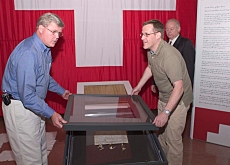Keeping the Swiss memory alive in the US

Erdmann Schmocker, former president of the Swiss American Historical Society, tells swissinfo about his hopes and fears for this little-known and declining community.
Bern-born Schmocker, who has been described as the “living memory” of Swiss-origin Americans, came to the United States in 1951 at the age of 20. An architect by trade, he has taught at universities in the US for almost 40 years.
swissinfo: What were the main periods of Swiss immigration to the United States?
Erdmann Schmocker: The first wave arrived in the 18th century. The first immigrants were mostly mercenary soldiers, although there were some traders as well. The main motivation for these young men was adventure.
During the American War of Independence there were whole regiments made up of Swiss – on both the American and British sides!
But the main waves came in the 19th century. Between 1830 and 1860 an economic crisis and the political changes reflected in the Swiss Constitution of 1848 made many Swiss emigrate – many nobles but also farmers who went to Pennsylvania and Ohio in particular.
Between 1870 and 1890 most Swiss immigrants were attracted by the new lands in the West Appalachians, firstly to Indiana and Illinois, and then to regions confiscated by the American government from Native Americans in Kansas, Nebraska and the Dakotas.
In order to buy a plot of land of around 4m², these immigrants had to prove they had lived there for a year and had to pay the amount fixed by the federal government.
swissinfo: The Irish, Jews and Chinese all faced discrimination in the US. Were the Swiss affected?
E.S.: Not to my knowledge. There wasn’t any stigmatisation of the Swiss. Quite the contrary: some Swiss, such as the Mennonites, immigrated to the US to escape persecution.
swissinfo: Is the American of Swiss origin an endangered species?
E.S.: Yes. The number of Swiss immigrants to the US was tiny in the 18th century, but the community rose to 300,000 in the following century. There were new arrivals at the beginning of the 20th century – technicians and members of the professions.
The last immigration wave came in the 1950s. After that date the economy and standard of life in Switzerland developed markedly and the need to emigrate was no longer felt.
There are one million Americans of Swiss origin now, whereas there were two million 20 years ago.
There are many reasons for this decrease. There hasn’t been any immigration for more than half a century. What also happens is that when Swiss are asked by the US Census Bureau about their origins, many mistakenly assume their ancestors come from Germany. Then, from the fourth generation onwards, immigrants tend to think of themselves first and foremost as American and to blend into the general population.
I predict that in the next census, slated for 2010, there won’t be more than 750,000 Americans claiming Swiss origin and I fear that in 20 years, the Swiss-American community will have completely disappeared.
swissinfo: But aren’t Swiss-Americans becoming more interested in their heritage?
E.S.: The conscious effort to maintain Swiss heritage in the US is a 20th-century phenomenon. Before that, immigrants were mostly worried about survival. The town of New Glarus, which has become the premier Swiss village in the US, didn’t really reach its present form until 1940, when an economic crisis hit the local agriculture and dairy industry.
People were leaving the region to find work. Leaders in New Glarus then started to wonder what they could do to ensure the village’s survival. They came up with tourism. They consulted the University of Wisconsin and the Swiss American Historical Society and the idea formed of building Swiss chalets and developing Swiss heritage to give the town and its region a new economic impetus.
swissinfo: The Swiss government is continuing its Swiss Roots project for the US into 2007. Could this help reinforce identity among the Swiss-US community?
E.S.: I’m not sure if the Swiss Roots bus tour [of the US] has made much more than a fleeting impression. I’d like a more long-lasting commitment. The Swiss government needs to help build something durable here and to support the towns where many Americans of Swiss origin live.
Some of these places are very motivated and gather resources themselves. Look at Bern in Kansas, where the inhabitants worked for 2,000 hours to restore a historical building.
The archives of living history, assembled by myself and others, should also be opened to the public. Living history is based on people and this oral history deserves to be preserved.
swissinfo-interview: Marie-Christine Bonzom in Washington
The two main waves of Swiss immigration to the US took place in 1830-1860 and in 1870-1890.
1.2 million Americans say they have Swiss origins.
The US states with the most Swiss Americans are California, New York State, Ohio, Pennsylvania and Wisconsin.
5,000 US towns and villages have Swiss names.
Erdmann Schmocker has been a member of the Swiss American Historical Society for almost 30 years. He was its president from 1994 to 2001.
He was born in Bern in 1931 and emigrated to the US with his parents at the age of 20.
His parents, a painter/decorator and a dressmaker, left Switzerland for economic reasons and settled in Idaho Falls, where friends had emigrated two years before.
Schmocker studied architecture in Bern and Chicago, before teaching for almost 40 years at US universities, notably at the Illinois Institute of Technology.
Schmocker’s passion is living history and in 1966 he decided to create a map of all the Swiss origin places in the US and to collect contacts – in addition to oral, iconographic and written archives – from the field.

In compliance with the JTI standards
More: SWI swissinfo.ch certified by the Journalism Trust Initiative











You can find an overview of ongoing debates with our journalists here . Please join us!
If you want to start a conversation about a topic raised in this article or want to report factual errors, email us at english@swissinfo.ch.